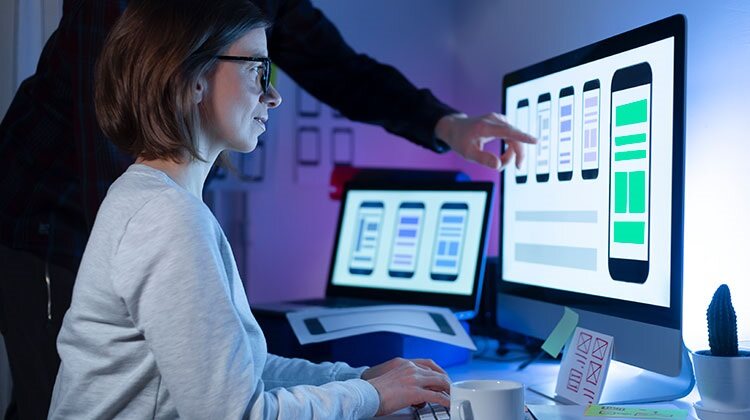The Mobile App Development Process: From Concept to Launch

The mobile app development process is a multi-stage journey that begins with an idea and culminates in the launch of a functional app.
These stages include conceptualization, planning and design, technical feasibility assessment, app development, testing, launch and deployment, and post-launch support and maintenance.
Each stage is critical and contributes to the overall success of the app. This article will provide a detailed exploration of these stages to explain the mobile app development process.
Conceptualization Phase
Before anything else can happen, you have to have a firm concept of the app you want to build. That involves market research, defining the problem you want to solve for your users, figuring out the primary features, and thinking about the user experience.
Market Research
Market research is the first and one of the most critical steps in the conceptualization stage. It involves gathering and analyzing information about the target audience and competitors. Understanding the target audience—their needs, preferences, and behaviors—helps shape the app’s features and functionalities, ensuring that it provides value to its users.
In-depth competitor analysis allows identifying gaps in the market and opportunities for differentiation. It’s crucial to know who the competitors are and understand their strategies, strengths, and weaknesses.
Problem Definition
A successful mobile app often solves a problem or fulfills a need for its users. Therefore, clearly defining this problem or need is essential to the conceptualization process. This involves formulating a precise problem statement that outlines the specific issue the app seeks to address.
A well-defined problem statement provides direction for the development process, ensuring that the final product serves a clear purpose and offers value to its users.
Primary Features and User Experience
Once the problem or need is defined, the next step is conceptualizing the app’s primary features to address this problem. This includes outlining the app’s core functionalities and deciding how these features will interact.
At the same time, it’s also important to think about the app from the user’s perspective—what journey they will take through the app and what interactions they will have along the way. The aim is to create an intuitive, seamless, and enjoyable experience that keeps users coming back.
Planning and Design Phase
Before diving into actual development, a detailed project plan is critical to guide the process and ensure all team members are on the same page. This plan should include key milestones, deadlines, resource allocation, and a risk mitigation strategy.
A well-structured plan ensures the development process is organized, on track, and within the predetermined timeframe and budget.
Wireframing and Prototyping
Wireframes serve as the “blueprints” of the app, providing a skeletal outline of its structure, layout, and key elements. They help visualize the app’s appearance and function, facilitating early feedback and revisions.
A prototype—a preliminary version of the app—is developed following wireframes. Prototyping brings the wireframes to life, enabling developers and stakeholders to explore the app’s functionality and user interface.
User Interface (UI) and User Experience (UX) Design
The success of a mobile app significantly depends on its UI and UX design. The user interface (UI) pertains to the app’s visual design—the colors, typography, images, buttons, etc., that users interact with. A well-designed UI is intuitive, responsive, and aesthetically pleasing.
On the other hand, user experience (UX) focuses on the overall user journey through the app—from first opening it to achieving their goal. A good UX design is seamless and enjoyable, ensuring users can easily navigate the app and complete their desired tasks with minimal friction.
Solid UI and UX design principles enhance user engagement, satisfaction, and, ultimately, the app’s success.
Feasibility Assessment
Once the initial design is in place, performing a technical feasibility assessment is essential. This step determines whether the proposed features and functionalities of the app can be implemented with the available resources, within the budget, and within the project timeline.
It involves analyzing technical requirements and potential constraints related to the platform, device specifications, integration with other systems, and more.
Tech Stack Selection
The tech stack selection is a critical decision in the app development process. The tech stack refers to the combination of programming languages, tools, and technologies used to build the app. It significantly influences the app’s performance, scalability, and maintainability. The choice depends on various factors, including the nature of the app, platform (iOS, Android, or cross-platform), desired features, and the team’s expertise.
Risk Assessment
Identifying potential technical challenges in advance helps mitigate risks and prevents future roadblocks. These could include performance issues, compatibility problems with different devices or operating systems, challenges integrating with other systems or third-party services, security vulnerabilities, etc.
Early identification of these challenges allows the team to develop appropriate solutions or workaround strategies, ensuring a smoother development process and a more robust final product.
Development Phase
App development consists of two primary parts: backend and frontend development.
The back-end, often called the “server side,” is responsible for the app’s core functionality. It includes the server, database, and application, managing data storage, user authentication, business logic, and integration with other systems. Its efficiency directly impacts the app’s speed, performance, and overall user experience.
The front-end, or the “client-side,” is the part of the app that users interact with. It involves creating the user interface and implementing user experience designs. It ensures the app looks good and functions seamlessly on different devices and screen sizes.
Both frontend and backend development are critical, working together to create a cohesive, functional, and user-friendly app.
Platform-Specific Development
Developing an app for iOS or Android requires different programming languages and development tools. iOS apps are typically created using Objective-C, Swift, and Xcode, while Android apps are developed using Java, Kotlin, and Android Studio.
Alternatively, there are cross-platform solutions like React Native or Flutter, which allow the development of a single app that runs on both iOS and Android.
The choice between native and cross-platform development depends on factors like budget, time, performance needs, and target audience.
Integration
If the app needs to communicate with other systems—like a website or a database—or use third-party services—like social media logins or payment gateways—it’s during the development phase that these integrations occur. Ensuring these integrations work seamlessly is essential, as they can greatly enhance the app’s functionality and user experience.
Quality Assurance Phase
Quality assurance (QA) is a crucial stage in the app development process, aimed at identifying and fixing any issues or bugs before the app goes live. Rigorous testing helps ensure the app works as expected, improves its quality, and enhances user satisfaction. It minimizes the risk of app failure, negative user reviews, and costly post-launch fixes.
Types of Testing
Different types of testing are performed to check various aspects of the app:
- Functional testing ensures all the app’s features and functionalities work correctly.
- Performance testing checks the app’s speed, responsiveness, and stability under different conditions and loads.
- Security testing verifies that the app and its data are secure from potential threats and vulnerabilities.
- User Acceptance Testing (UAT) ensures the app is user-friendly, intuitive, and meets user expectations.
Each type of testing plays a vital role in delivering a high-quality, reliable, and secure app.
The Role of Beta Testing
Beta testing involves releasing the app to a select group of end-users to get real-world user feedback. It’s an excellent opportunity to understand how users interact with the app, identify any usability issues, and validate whether the app meets user needs and expectations.
The feedback and insights gained from beta testing are invaluable in making final tweaks and improvements before the official launch.
Launch and Deployment
Before launch, the app undergoes a series of final checks to ensure that all features function as expected and that there are no lingering issues. It is essential to ensure the app complies with the guidelines of the platforms it will be launched on.
In addition to these checks, preparing the app for launch involves App Store Optimization (ASO). ASO is the process of optimizing the app’s title, description, keywords, screenshots, and other elements to improve its visibility in the app stores and increase its chances of being downloaded.
Deployment Strategies
Deployment strategies may vary depending on the platform. For iOS apps, developers submit their apps to the Apple App Store for review, which can take a few days. If the app meets Apple’s guidelines, it gets published in the store.
For Android apps, developers submit their apps to the Google Play Store. The review process is generally quicker than Apple’s. Google also allows developers to publish their apps in phases, enabling them to gather user feedback and fix potential issues before a full-scale rollout.
Planning the Launch Strategy
An app’s success is not only about development and deployment but also about a well-executed launch strategy. This includes deciding on the launch date, coordinating marketing and PR activities, planning for user acquisition and retention, setting up analytics to track app performance, and preparing for user support.
A successful launch can boost initial app downloads, attract more users, and lay the foundation for the app’s long-term success.
Post-Launch Support and Maintenance
The app development process doesn’t end with the launch. It requires ongoing support and maintenance to ensure its continued success. Maintenance activities include fixing bugs, resolving user issues, optimizing performance, and ensuring the app stays compatible with the latest operating system updates and device configurations. Continuous support improves the app’s reliability, enhances user experience, and increases user retention.
Keeping the App Relevant
Regular updates and feature additions are essential to keep the app engaging and relevant in a competitive market. These updates can involve introducing new functionalities, enhancing existing features, improving UI/UX, or refreshing the app’s look and feel. Regular updates signal to users that the app is actively maintained and evolving to meet their needs and expectations.
Analyzing User Feedback
User feedback is a valuable resource for continuous app improvement. It provides insights into what users like about the app, what they don’t, and what new features they might want. User reviews and ratings, direct user feedback, user behavior analytics, and user testing sessions can all provide these insights. Leveraging this feedback to guide updates and enhancements ensures that the app continues to meet and exceed user expectations, thereby improving user satisfaction and app success.
Conclusion
In the entire mobile app development process, skipping or not fully committing to any of the stages can compromise the app’s quality, user experience, and, ultimately, its success. Each stage of the process provides an opportunity to refine the app further and align it more closely with user needs and expectations.
For a successful mobile app, you must stay abreast of the latest trends in mobile technology and user behavior, continuously gather and act on user feedback, invest in a good UI/UX design, focus on app performance and security, and maintain a regular update schedule.

